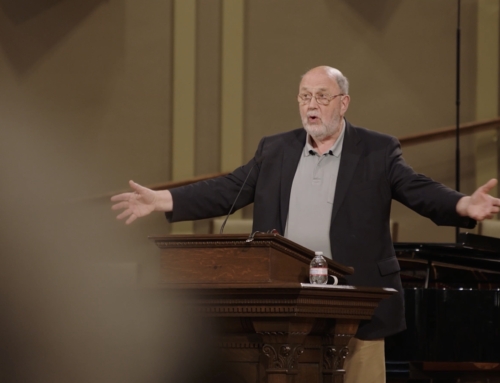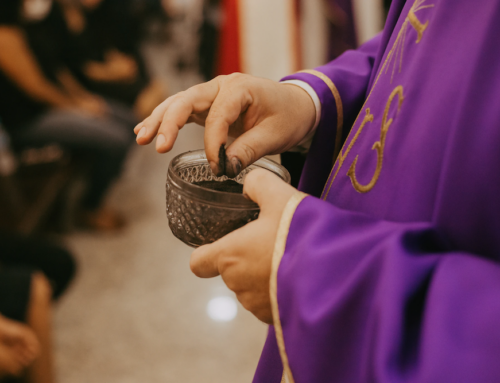Sometimes, when my husband, Gary, and I are speaking together at a seminar or conference, he will introduce himself as, ‘Mr. Jennifer Loop’, which always gets a chuckle from the audience. It is fitting because he used to be a former professional stand-up comedian, and even after twenty years of marriage, this bit still makes me smile. I know it is Gary’s way of encouraging me to continue speaking, preaching, and writing, when most days I would rather hide instead. My husband’s introduction, which he offers humorously and affectionately, is also, in my view, a nod of support for the ecclesial need to balance the roles men and women serving and leading together.
Who is ‘Right’?
Last year, as our lives were upended by the COVID 19 pandemic, a popular slogan formed: ‘together yet apart’. This phrase also describes how some might answer the question regarding how the leadership roles of men and women should be organised or lived out in the church—and here, by ‘church’ it seems to me that what many people mean is, ‘within the physical church building’, or the tangible place or space where believers gather for worship. Although, there are some who believe that women should not take the primary lead in any setting where men are present.
So, who is ‘right’?
If I’m honest, I think I might answer, ‘I’m not sure’. More importantly, however, I’m not sure that starting out by asking ‘Who is right?’—presumably, the complementarian or egalitarian position—always feels like the ‘right question’ for me to lead off with in dialogue with another person who disagrees about the issue of women in ministry. Generally, it has been my experience that defending my position of ‘being right’ isn’t the most useful approach. Rather, seeking to understand another person is often more important than being understood.
Regrettably, there have been instances when I’ve won the argument but lost ground in building the relationship. The painful reality seems to be that there are times when parting ways on a certain theological issue results in parting ways in real life. However, my hope is that there can and will be Spirit-led discernment in specific situations for the time to tear down and the time to build, or the time to tear and the time to mend (Eccl 3:3b, 7a)
One way forward might be to ask, ‘How can persons best respect one another in the church when we disagree without giving up on holiness or unity?’, or, ‘What are some practical ways individuals can maintain unity when we believe holiness or obedience is at stake?’ The answers to these questions, of course, depends on the specific persons or individuals involved, their respective relationships, unique perspectives and distinct biases, and a myriad of other things—such as various historical or generational injustices—that are germane to the particular context.
Using myself as an example, I’ve written before about the fact that I still have my head covering, mantilla, which I used to wear during worship. It is in my top drawer and it’s the one that pictured in this article. Why do I still have my mantilla? Allow me a brief autobiographical detour.
 I came to faith through a childhood friend, Jackie, at the age of 15. It took me five years before I finally stepped foot in any house of worship. By the leading of the Spirit, one day I asked Jackie, ‘out of the blue’, if I could go to church with her. That same night, I worshipped at ‘Meeting’ with Jackie and the assembly of Plymouth Brethren gathered in Oakland, CA. I was baptized shortly before my 21st birthday. It was, and is, one of my most precious memories. My love and respect for the brothers and sisters in this assembly remains strong to this day. When I moved from CA to WI a few months after my baptism, the closest meeting was three hours away. It was a gut-wrenching decision for me to leave fellowship with the Brethren, but I never gave my head covering back.
I came to faith through a childhood friend, Jackie, at the age of 15. It took me five years before I finally stepped foot in any house of worship. By the leading of the Spirit, one day I asked Jackie, ‘out of the blue’, if I could go to church with her. That same night, I worshipped at ‘Meeting’ with Jackie and the assembly of Plymouth Brethren gathered in Oakland, CA. I was baptized shortly before my 21st birthday. It was, and is, one of my most precious memories. My love and respect for the brothers and sisters in this assembly remains strong to this day. When I moved from CA to WI a few months after my baptism, the closest meeting was three hours away. It was a gut-wrenching decision for me to leave fellowship with the Brethren, but I never gave my head covering back.
It is vital to acknowledge that for some persons, head coverings have been used as a coercive or abusive symbol of control or silencing that limits freedom. I have heard directly from some whom have been harmed by these various abuses of power. In some instances, those who have questioned or refused to wear head coverings have faced backlash, punishment, or worse. A helpful comment someone shared with me that expanded my thinking in this area, is that what might seem to be cheerful compliance on the surface can sometimes be masking forced compliance in actuality. Subsequently, I’ve written on the need to safeguard persons in the church and to prevent abusive theology.
Yet, I choose to keep my head covering. For me, this means not having all the answers, wrestling with theological tensions, and being very much aware of the fact that just as much as Christ died so that I might stand firm in freedom, I might also be asked to stand down by giving up my ‘rights’, covering my head, or remaining silent. If I worship again back home with the Oakland assembly, I’d cover my head as a sign of honour, respect, and submission in that gathering of believers—even though I’m confident no one there would mind whether I wore one or not.
Morna Hooker’s reflections in Interchange in Christ and Ethics are useful at this point. She writes,
How should Christians behave towards fellow-Christians with whom they disagree? They must welcome one another, since they have all been welcomed by God himself (Romans 14.1-3). They must be careful not to injure one another by their behaviour, since that would bring destruction on those for whom Christ died (Rom 14.13-21).
In the article, Hooker summarises the words of Irenaeus and describes an ‘interchange’ that takes place whereby ‘Christ became what we are, in order that we might become what he is’ (p. 6). She offers that ‘interchange’ is not entirely satisfactory because it suggests that Christ and the believer simply change places. Yet, what is noteworthy for the discussion about disagreements of women in ministry in general and safeguarding persons from abuse in the church is her observation that we must honour a ‘mutual give and take’ (p. 6).
It is my view, that in the spirit of mutuality, we must first ensure persons are not harmed. Paul C. Maxwell argues rightly that the church’s primary concern for abuse survivors should be the process of healing—’their existential safety, not their ecclesial submission’. Part of this work, for me, has been to receive the stories of others whose experience is different from mine–those who have been harmed by the sign and symbol of head coverings or silenced abusively in their churches. I keep my head covering because it reminds me positively of a time when I came to faith. I also keep it in remembrance of the tensions and abuses that yet exist in other ecclesial settings.
How We Use the Bible
I’m suggesting that tensions related to how the roles of women and men should be ordered in the church can benefit from acknowledging and investigating past harm, as well as exploring how the Bible can be used against people in harmful ways. Angus Paddison poses some helpful interpretive questions in his book, Scripture: a Very Theological Proposal (2009):
- What is Scripture?
- What is the task of offering an account of Scripture’s location, whose own overarching question is, In the context of what kinds of action is Scripture intelligible? (5).
Paddison suggests we must ‘disentangle our minds from the notion that Scripture is a latent or independent text waiting to be ‘used’ in crisis situations abstracted from thicker contexts of {ecclesial} performance’ (33).
Additionally, the epistemological move to recognize lived Christian experience as a valid source of theological knowledge might expand our interpretive horizons helpfully beyond ‘a plain reading of the text’. For example, what is the plain reading of head coverings ‘because of the angels’ (1Corinthians 11:10b), or that long hair is a woman’s glory (v 15)?
In Professor N.T. Wright’s course on 1 Corinthians, he teaches that the Apostle Paul was negotiating the issue of men and women in the church ‘cautiously and in an exploratory way’ as he formed arguments for what it meant to embody the celebration of the church as God’s in-Christ-and-for the Kingdom people. Prof. Wright observes that for Paul, the crucial issue was the public witness of the church, which remains an important consideration for us today. Paul was concerned that the Corinthian church demonstrate mutual respect, shared leadership, the ‘God-givenness’ of maleness and femaleness, and the need for worship that celebrates we are now like ‘creation restored’. Prof. Wright observes, ‘Paul does not think that, if women have a place in a hierarchy of being, that it is purely in a place of subservience’.
So, what might a mutual and shared way of ‘creation restored’ look like in contemporary practice when there are such dissimilar views of what the truth of Scripture is saying to us? How might we reposition the triangulation that situates Christians at the proverbial fork of choosing between complementarianism and egalitarianism? What I have tried to suggest is that we consider when and how we ought to place persons before principles. I’ve argued that theology is problematised when our concern for safeguarding abstract theological commitments is prioritised over against safeguarding persons in real life.
Loosening Our Grip
In order to preserve unity, we might loosen our grip on labels and categories that create impermeable borders and unhelpful binaries, and rather meet as persons in the Kingdom of God together against the dark forces still at work in the world and the human desire for power and the need to be ‘right’. We might come together to consider how the Apostle Paul’s letter to Corinth reinvigorates the church today to cautiously explore new possibilities for the worshipping church. These new horizons of possibility might find convergence and mitigates harmful practices of domination in ecclesial settings.
I’ll leave you with an example of this in ‘real-life’. A while ago, I was getting ready to preach and several people gathered for prayer. Someone in the group tapped a guy on the shoulder and asked him to pray. I’m fairly confident that at this particular point in time, he did not agree with women preaching in the presence of men. I was a bit worried about what he would say or do. To my surprise, he not only prayed for me and the message I’d prepared, but he prayed that I would be bold and that I would not hold back or be constrained in any way. It was a very humbling experience, and still is. I often wonder what I would do, or will do, if I were in his shoes.
I’m trusting prayerfully for the Spirit’s guidance for knowledge of his will for me and to discern the time to be silent and the time to speak (Eccl 3:7b).
Jennifer Loop
Latest posts by Jennifer Loop (see all)
- Why You Need Lent: Two Perspectives - February 22, 2023
- How (Not) To Understand a Parable - October 20, 2022
- What People are Saying About ‘Ethnicity, Justice and the People of God’ - February 10, 2022







